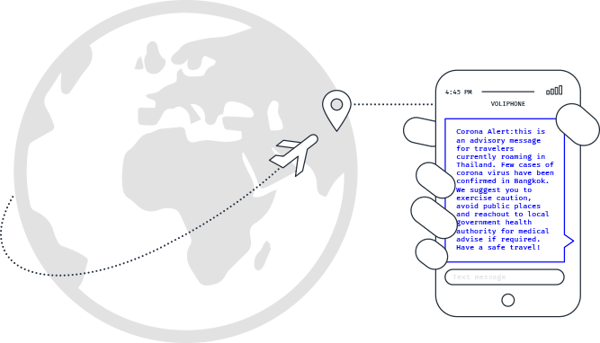The spread of the COVID-19 coronavirus has travelers around the world on edge. People across the world are growing concerned that the virus will continue to spread and eventually reach their country, or a country they are travelling to. Much is still unknown about the outbreak, and health officials are urging caution. That means travelers crisscrossing the globe should be aware of the virus outbreak in each travel destination, steer clear of heavily impacted areas, and exercise precautionary measures.
Several countries have already issued advisories, discouraging travel to select destinations and urging caution while travelling to others. However, it has been observed that the virus is spreading more sporadically across the world with time, and that travelers may get caught unaware of its spread in the midst of their journey. Mobile operators can play a very crucial role in disseminating the right information in these instances, providing local updates about the virus outbreak, as well as sharing travel advisory and precautionary measures that can help avoid chaos and confusion.
For example, mobile operators can notify outgoing travelers / outbound roamers in affected destinations about the nature of the emergency and what they need to do in response aligned to regional travel advisories.
- Mobile operators can communicate with outbound roamers travelling to affected countries via a Welcome Advisory SMS suggesting they exercise caution when entering affected areas.
- In case there is a sudden outbreak or increase in spread within any destination, Mobile operators can send Emergency Broadcast messages to all outbound roamers traveling within the affected areas.
- Mobile operators can send Welcome Back messages to outbound roamers returning from affected countries, suggesting they exercise caution and provide contact information for relevant government / medical authorities in case of suspected infection.Mobile operators can also proactively reach out to incoming travelers (inbound roamers) with relevant advisories.
- Inbound roamers can be notified via Welcome Advisory SMS about the precautionary steps, emergency health contacts, or places to avoid during their travel.- In case of a sudden outbreak, mobile operators can send an emergency broadcast message to all Inbound Roamers, sharing advisory information and relevant steps to take.

During these challenging times, Mobile operators need an effective solution that can enable proactive outreach to outbound and inbound roamers during their travels. Mobileum’s iCampaign offers a holistic solution in this aspect. In addition to the advanced, end-to-end Campaign Management capabilities for contextual outreach to roamers, iCampaign also supports sending real-time, automated broadcasts and SMS messages, updating roamers about any hazardous / emergency situations within a travel destination. iCampaign relies on network probes to track roamer movements in real time and provides CSPs with an intuitive GUI for configuring advisory messages. These can be contextualized, depending upon travel stage, travel destination, network, and even the preferred language for communication.
With proper awareness, preparation and contextual messaging, millions of travelers can be contacted at the right time, helping to keep the public better informed and potentially reduce the spread of an epidemic.
For more details on Mobileum’s iCampaign solution, please contact us.



Let Us Know What You Thought about this Post.
Put your Comment Below.